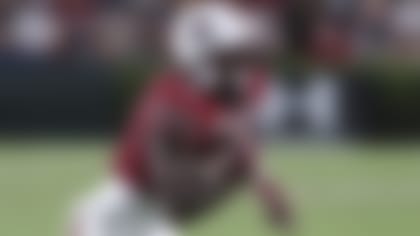Every Tuesday, Bucky Brooks will bring a scout's perspective to some of the hot topics around the league.
Hue Jackson has turned Darren McFadden into the league's top runner. Fans of Adrian Peterson and Chris Johnson will take umbrage with that assessment, but it is hard to dismiss McFadden as a viable candidate for the title.
McFadden currently leads the league in rushing yards (393) and has produced five runs of 20-plus yards. His hefty 6.4 yards per attempt average is tied for the league lead (with Bills RB Fred Jackson) among runners with at least 30 carries. And he has rushed for 150-plus yards twice in three contests.
While that is the kind of production the Raiders expected when nabbing McFadden with the fourth overall pick in the 2009 draft, it wasn't until the arrival of Jackson that McFadden started realizing his potential. Jackson provided his star runner with more opportunities and tailored the Raiders' ground game to accentuate McFadden's strengths as an explosive perimeter runner.
Rather than pound the 6-foot-2, 210-pounder between the tackles, Jackson has used a variety of off-tackle plays to take advantage of McFadden's speed, burst and cutback ability. For instance, his 70-yard touchdown against the Jets came on a stretch play from a one-back set. The play was designed to hit slightly off tackle, but McFadden bounced it outside and used his speed and acceleration to take it the distance.
Jackson also has used unbalanced lines and power formations to create a numbers advantage at the point of attack to create room. By getting an extra blocker on the front side, the Raiders are able to spring McFadden to the second level, which allows him to get loose in the open field.
Even though most of McFadden's production appears to come on outside runs, Jackson has gotten him to be more productive on downhill carries. Part of that improvement can be attributed to McFadden's ability to finish his runs with power. He routinely falls forward at the end of runs and his renewed toughness has made him one of the most difficult runners to bring down. As a result, he has eight 100-yard games since the start of 2010 and emerged as the most dangerous runner in the game.
Philly's star-studded secondary has been a major disappointment. Much of the hype surrounding the Eagles in the preseason revolved around going after the best defense that money could buy. Opponents not only were expected to be under constant pressure from a rebuilt defensive line spearheaded by newcomers Jason Babin and Cullen Jenkins, but also be blanketed by Nnamdi Asomugha, Dominique Rodgers-Cromartie and Asante Samuel.
While the revamped front line has certainly lived up to the hype, the secondary has fallen woefully short of expectations. The unit has surrendered eight touchdowns, tied for the most in the league, and only produced two interceptions. They also have allowed two completions of 40-plus yards and been torched by unheralded receivers.
Asomugha, in particular, has struggled despite being regarded as the premier shutdown corner in the league. He has been caught out of position on deep throws and his inability to snuff out the likes of Victor Cruz and Brandon Gibson is a concern considering the elite receivers remaining on the Eagles' schedule.
Part of Asomugha's woes in coverage could be attributed to transitioning into a scheme vastly different from the one he thrived in as a Raider. He is being asked to play more zone coverage, and isn't completely comfortable playing away from the line of scrimmage. He is also occasionally aligning over the slot receiver, which requires different techniques than he is accustomed. Regardless of the circumstances, Asomugha was expected to raise the level of play in the back end and he has failed to do so thus far.
Rodgers-Cromartie also has been a slight disappointment as a nickel corner. He hasn't been solid as a tackler, and his misses have resulted in big gains. He has also failed to deliver the big plays expected of him when the Eagles traded for him in the offseason. He has no interceptions and just one break-up.
Of the Eagles' star-studded corners, Samuel has played the best to date. He has provided solid coverage on most downs despite rarely seeing a ball head in his direction. His gambling ways, however, will result in a receiver slipping behind him at times. He compensates for his risky play by delivering turnovers. He is responsible for one of the Eagles' two picks and his ability to jump routes dissuades quarterbacks from testing him. While he could certainly become a better tackler, it is hard to nitpick based on his performance compared to his counterparts.
Defensive coordinator Juan Castillo has come under fire for failing to get his unit to perform, and he will continue to feel the heat until his secondary proves its worth.
Sidney Rice's return will make the Seattle Seahawks' offense the best in the West. As crazy as it sounds, now that the former Pro Bowler is healthy, it gives the Seahawks the most explosive offense in the division.
The 6-foot-4, 202-pounder is one of the best pass-catchers in the league, and defenses have to account for his every move with an assortment of double-teams. This opens up the field for the Seahawks' other weapons and allows the offense to finally develop a rhythm.
In looking at the Seahawks' 13-10 win over the Cardinals, it was apparent that Rice's presence led to improved play from Tarvaris Jackson (18 of 31 for 171 yards) and Marshawn Lynch (19 carries for 73 yards). Both were fairly productive for the first time this season, and the clever use of Rice keyed their surge.
Rice's range encouraged Jackson to take more chances in contested situations, which resulted in more big plays. Rice also provided Jackson with someone to turn to in critical situations. This overlooked aspect has been a major factor in Jackson's early-season woes, but that seemed to disappear with Rice on the field.
Lynch also benefitted from Rice's presence. He finally found room to run after being snuffed out by the eight-man fronts thrown at the Seahawks in previous weeks. With Rice flanked out wide, however, the defense is faced with the decision of leaving him isolated with a corner without safety help or sending some form of double coverage in his direction. When the defense opts to take a defender out of the box, Lynch has more room to run. His 23-yard run early in the game illustrates the kind of room Rice provides the ground game.
With Zach Miller and Mike Williams also capable of delivering big plays, it is only a matter of time before they also find more room to work with Rice on the field.
Follow Bucky Brooks on Twitter @BuckyBrooks





